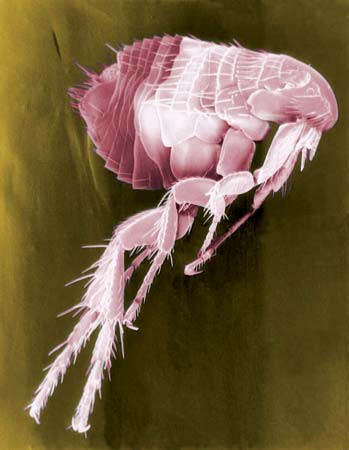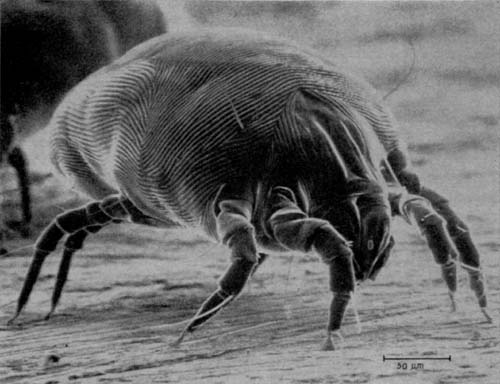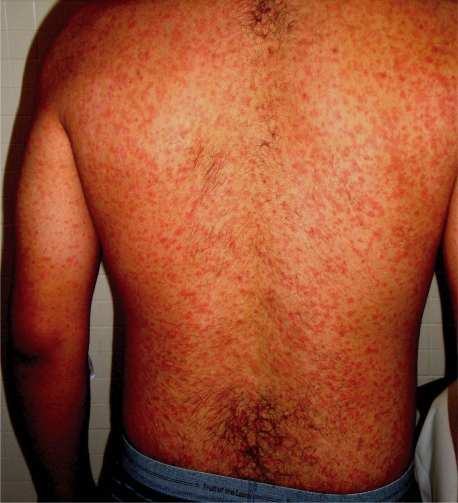Clinical Manifestations And Health Significance Of Endemic Typhus, Scrub Typhus And Tick-Borne Typhus
Flea Are The Vectors For Murine Typhus

Endemic Typhus (Murine Typhus, Flea Typhus)
This is an acute febrile illness caused by R. typhi (R. mooseri) transmitted from rat to man by the rat flea Xenopsylla cheopis.
Etiology: The rate flea and the rate louse (polypax spinulosis) transmit R. typhi among rodents. The insect acquires the infection while feeding on an infected rat. The organisms are passed in the feces of the flea after multiplication in the intestinal cells. Man is infected by the flea when it takes a blood meal. The bite wound is contaminated with flea feces and the organisms get in. Infection may also enter through the respiratory tract or the conjunctiva. Since the urine of infected rats contains the organisms, contamination of food with rats urine is also a possible source of spread. Rats and mice may harbor the organisms in their brain for long periods. Lice have been incriminated as vectors in some areas in Kashmir (India) and China. Compared to epidemic typhus, endemic typhus is milder.
Clinical features: After the incubation period of 8 to 16 days, prodromal symptoms like headache, backache and arthralgia develop, followed soon by the onset of fever. Fever may be associated with frequent chills, rigors, nausea, vomiting, photophobia and congestion of the eyes. The fever persists continuously for 12 days and then comes down by lysis. A morbilliform rash develops in the axillae, arms, abdomen, chest, shoulders and thighs by about the fifth day and it fades away. Bronchitis may develop and this is manifested as cough and the presence of rales on examination. Rare complications include stupor, coma, prostration and renal failure.
Diagnosis: The clinical suspicion should be supported by laboratory investigations.
Treatment: The disease responds to cholramphenicol or tetracycline.
Mites Are The Vectors For Tsu tsuga-Mushi Fever Or Japanese River Fever

Scrub Typhus (Mite Typhus, Mite Fever, Tsu tsuga-Mushi Fever, Japanese River Fever)
Infection by Rickettsia tsutsugamushi leads to a febrile illness which lasts for about 2 weeks.
Epidemiology: The disease occurs all over the eastern parts of Asia, Pacific Islands and Australia. It is transmitted by different species of mites. In Japan, the vector is Trombicula akamushi. In India, scrub typhus is endemic in many regions and the vector is T. deliensis. Mites are seen in scrub jungles mainly, but they are also seen in sandy beaches, deserts and dense forests. Reservior of infection is formed by wild rodents and birds. Mites are infected when they take their blood meal during the larval stage (Chiggers). Only larval mites suck blood. The infected mites transmit the organisms transovarially to the offspring. Thus a colony of mites which harbor organisms develops which acts as a reserviou of infection for a long periods. Man gets the infection from the mites, which are acquired when engaged in jungle clearing operations or war. Pathologically, the lesions resemble those caused by Rickettsia prowazekii.
Clinical features: The incubation period varies from 6 to 18 days. The onset is abrupt with rigor, severe headache, fever and lymphadenopathy. At the site of bite, a necrotic ulcer (eschar) develops with local lymphadenopathy. Fever may go up to 38 to 39.50C. It is associated with relative bradycardia. The cutaneous rash appears after the fifth day, first on the trunk and then it spreads to the extremities. It may persist for a few days. Fever lasts for about two weeks and comes down by lysis.
Serious complications may occur. These include myocarditis, cardiac failure, renal failure and meningo- encephalitis. The mortality is around 6%. Convalescene tends to be prolonged.
Diagnosis: Clinical diagnosis should be made in endemic areas by the presence of the characteristic eschar, rash and lymphadenopathy. The weil- Felix reaction is positive for OX- K. Rising titer of antibodies demonstrated at the end of three weeks is more suggestive.
Treatment: Chloramphenicol and tetracycline are effective against the organisms when given in a dose of 2 to 4 g/day. Within 24 hours of starting therapy, the temperature falls and recovery starts. Infection can be avoided, in endemic areas by wearing protective clothing and using insect repellants.
Physical Presentation Of The Spotted Fever Group

Tick-Borne Typhus (Spotted Fever Group)
Many rickettsiae affect man, the disease being characterized by the development of a prominent rash. Most of them are transmitted by hard ticks (Ixodidae), except R. akari which is transmitted by mite. Rickettsiae of this group possess a common antigen and therefore may show serological overlap. These organisms are found in animals and enzootics occur periodically. They constitute the reservoir for infection. In addition, transovarian transmission of rickettsiae by the female tick to its offspring leads to the formation of an insect reservoir which tends to persist for long periods on account of the long lifespan of the ticks. Man is affected accidentally. The course of the disease is similar to that of epidemic typhus. Mortality differs from place to place, but is around 15 to 18%.
© 2014 Funom Theophilus Makama








